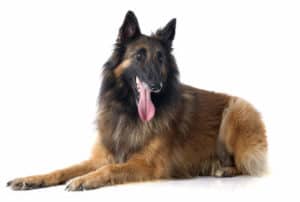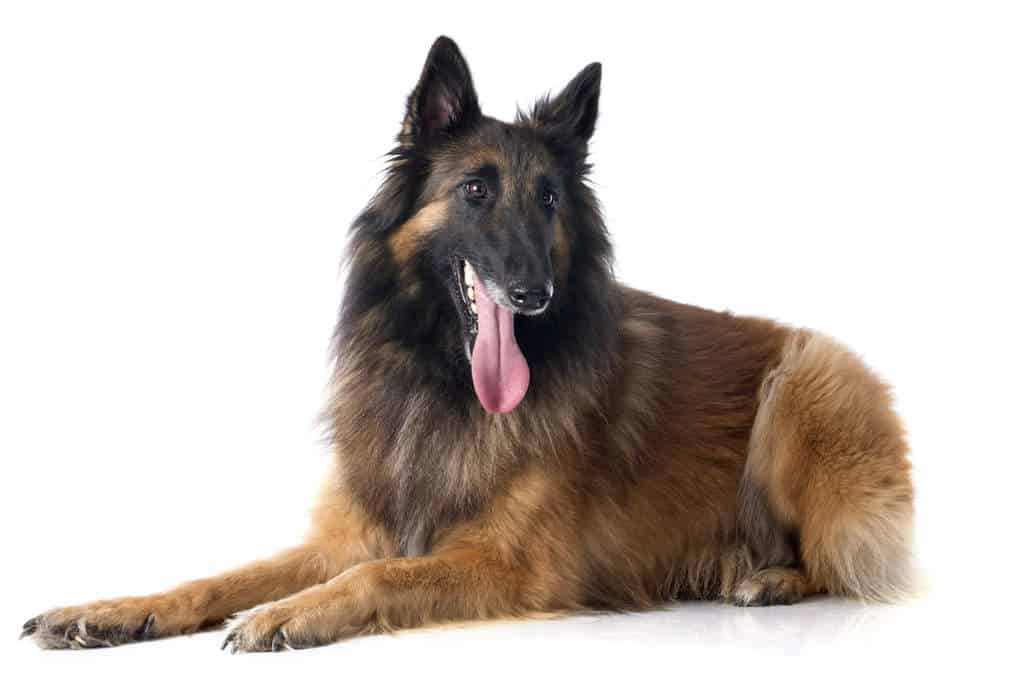 The Belgian Sheepdog is longhaired with a harsh-textured black coat; the Belgian Tervuren has the same coloring as the Belgian Malinois , but the outer coat is long, straight and abundant. All varieties (Belgian Sheepdog, Belgian Malinois, Belgian Tervuren and Laekenois ) have double-textured coats, with a harsh outercoat and a dense undercoat.Requires regular brushing at least once a week. Mature males tend to molt with the weather, but bitches lose their coats very dramatically about three months after they have been in season. They are likely to look quite dreadful at this point! The coat then takes about two months to grow back. Puppies have a much thicker, bigger coat than adults, which they lose when they are about a year old.
The Belgian Sheepdog is longhaired with a harsh-textured black coat; the Belgian Tervuren has the same coloring as the Belgian Malinois , but the outer coat is long, straight and abundant. All varieties (Belgian Sheepdog, Belgian Malinois, Belgian Tervuren and Laekenois ) have double-textured coats, with a harsh outercoat and a dense undercoat.Requires regular brushing at least once a week. Mature males tend to molt with the weather, but bitches lose their coats very dramatically about three months after they have been in season. They are likely to look quite dreadful at this point! The coat then takes about two months to grow back. Puppies have a much thicker, bigger coat than adults, which they lose when they are about a year old.
The Grooming Procedure
Equipment needed: Slicker brush and a good-quality comb.
Breed tip: This is an active, working breed that will need regular brushing to remove from the coat any debris acquired after their energetic walks.
- Use a slicker to brush through the coat, after spraying lightly with a conditioner to protect the hair and to encourage growth. The coat should always be brushed when damp, not when dry. Misting with water is fine if no conditioner is available, and indeed is the correct thing to use for show preparation (as water is the only substance that is permitted).
- The coat should be brushed up the wrong way and then brushed right down to the roots with the slicker. Work in sections to take the coat back the right way again.
- Pay particular attention to the trousers and ruff. Long hairs here and on the undercarriage can get very matted between the back legs.
- Where the undercoat needs removing, use a rake or a twisting-teeth comb.
- If the dog is in molt, use a molting comb to remove all dead hairs.
- If the dog is neutered, the coat needs a lot more attention as the undercoat can become very dense and clumped. Daily attention is needed for spayed bitches and castrated dogs, using a twisting-teeth comb, particularly on the rump, flanks and back legs. Light trimming of the very long, wispy hairs that can grow in the neutered coat makes the dog much smarter-looking and more comfortable.
- Obviously, the Belgian Sheepdog and Belgian Tervuren coats, being longer, need more attention than those of the shorthaired Belgian Malinois or the rough-coated Laekenois.
- Bathing these dogs is rarely necessary. If the dog is muddy, remove the worst with a bucket of cold water and a sponge (outside is best for this) or use a garden hose set at a gentle pressure. Dry the dog with an old towel and then, when it is nearly completely dry, gently brush out any remaining mud. The coat readily loses mud by using this method.
- Check the dog’s nails, ears and teeth.
- Next, investigate under the dog’s feet. If necessary, scissor out any excess hair and any build-up of debris.
- Finish with a light application of coat-enhancing spray.
- Note: the show dog may need a few days for the coat to settle after bathing.

